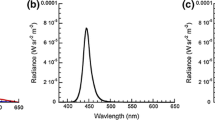Abstract
The mfERG provides a topographic map of function of the retina and has been used in numerous studies to identify macular, paramacular and peripheral retinal dysfunction. This study investigates the changes in response due to the presentation rate of the stimulus. Twenty subjects gave informed consent to take part in the study, which had local regional ethical committee approval. Only a single hexagon of 8° diameter was presented to reduce ambiguity when identifying the higher-order kernels (HOK). Six rates were tested using a 60-Hz CRT monitor by introducing blank (black ~0 cd/m2) filler frames (FF). The rates tested were 0FF; 1FF; 2FF; 4FF; 7FF; and 14FF. The first-order kernel had largest responses to the slower stimuli (4FF and above). HOK had largest amplitudes at faster rates with the second-order kernel peaking at 1FF. At rates with 4FF and slower, the higher-order kernels were indiscernible above the noise.









Similar content being viewed by others
Abbreviations
- FF:
-
Filler frame
- FOK:
-
First-order kernel
- HOK:
-
Higher-order kernel
- SOK:
-
Second-order kernel first slice
- SOSS:
-
Second-order kernel second slice
- TOK:
-
Third-order kernel
References
Lai TYY, Chan WM, Lai RYK, Ngai JWS, Li H, Lam DSC (2007) The clinical applications of multifocal electroretinography: a systemic review. Surv Ophthalmol 52:61–96
Sutter EE (1991) The fast m-transform: a fast computation of cross-correlations with binary m-sequences. SIAM J Comput 20:686–694
Sutter EE (1992) The field topography of ERG components in man-I. The photopic luminance response. Vis Res 32:433–446
Fricker SJ, Sanders JJ (1975) A new method of cone electroretinography: the rapid random flash response. Invest Ophthalmol 14:131–137
Hagan RP, Fisher AC, Brown MC (2006) Examination of short binary sequences for mfERG recording. Documenta Ophthalmologica 113:21–27
Marmor MF, Fulton AB, Holder GE, Miyake Y, Brigell M, Bach M (2008) Standard for clinical electroretinography (2008 update). Documenta Ophthalmologica 118:69–77
Hoffman MB, Flechner JJ (2008) Slow pattern-reversal stimulation facilitates the assessment of retinal function with multifocal recordings. Clin Neurophysiol 119:409–417
Hood DC, Seiple W, Holopigian K, Greenstein VC (1997) A comparison of the components of the multifocal and full-field ERGs. Vis Neurosci 14:533–544
Keating D, Parks S, Smith D, Evans AL (2002) The multifocal ERG: unmasked by selective cross-correlation. Vis Res 42:2959–2968
Sutter EE (2000) The interpretation of multifocal binary kernels. Documenta Ophthalmologica 100(1):49–75
Kondo M, Miyake Y, Horiguchi M, Suzuki S, Tanikawa A (1995) Clinical evaluation of multifocal electroretinogram. Invest Ophthalmol Vis Sci 36:2146–2150
Larkin RM, Klein S, Ogden TE, Fender DH (1979) Nonlinear kernels of the human ERG. Biol Cybern 35:145–160
Wu S, Sutter EE (1995) A topographic study of oscillatory potentials in man. Vis Neurosci 12:1013–1025
Granit R (1933) The components of the retinal action potential in mammals and their relation to the discharge in the optic nerve. J Physiol 77:207–240
Conflict of interest
None.
Author information
Authors and Affiliations
Corresponding author
Additional information
Study was NHS trust approved and conducted as part of job role.
Rights and permissions
About this article
Cite this article
Hagan, R.P., Fisher, A.C. & Brown, M.C. Investigation of the temporal properties of the retina using the m-sequence. Doc Ophthalmol 123, 179–185 (2011). https://doi.org/10.1007/s10633-011-9295-9
Received:
Accepted:
Published:
Issue Date:
DOI: https://doi.org/10.1007/s10633-011-9295-9




